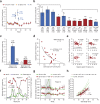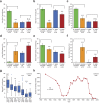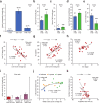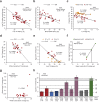Widespread episodic thiamine deficiency in Northern Hemisphere wildlife
- PMID: 27958327
- PMCID: PMC5153840
- DOI: 10.1038/srep38821
Widespread episodic thiamine deficiency in Northern Hemisphere wildlife
Abstract
Many wildlife populations are declining at rates higher than can be explained by known threats to biodiversity. Recently, thiamine (vitamin B1) deficiency has emerged as a possible contributing cause. Here, thiamine status was systematically investigated in three animal classes: bivalves, ray-finned fishes, and birds. Thiamine diphosphate is required as a cofactor in at least five life-sustaining enzymes that are required for basic cellular metabolism. Analysis of different phosphorylated forms of thiamine, as well as of activities and amount of holoenzyme and apoenzyme forms of thiamine-dependent enzymes, revealed episodically occurring thiamine deficiency in all three animal classes. These biochemical effects were also linked to secondary effects on growth, condition, liver size, blood chemistry and composition, histopathology, swimming behaviour and endurance, parasite infestation, and reproduction. It is unlikely that the thiamine deficiency is caused by impaired phosphorylation within the cells. Rather, the results point towards insufficient amounts of thiamine in the food. By investigating a large geographic area, by extending the focus from lethal to sublethal thiamine deficiency, and by linking biochemical alterations to secondary effects, we demonstrate that the problem of thiamine deficiency is considerably more widespread and severe than previously reported.
Figures





Similar articles
-
Wild birds of declining European species are dying from a thiamine deficiency syndrome.Proc Natl Acad Sci U S A. 2009 Jul 21;106(29):12001-6. doi: 10.1073/pnas.0902903106. Epub 2009 Jul 13. Proc Natl Acad Sci U S A. 2009. PMID: 19597145 Free PMC article.
-
Thiamine deficiency impairs common eider (Somateria mollissima) reproduction in the field.Sci Rep. 2017 Oct 31;7(1):14451. doi: 10.1038/s41598-017-13884-1. Sci Rep. 2017. PMID: 29089512 Free PMC article.
-
Severe thiamine deficiency in eastern Baltic cod (Gadus morhua).PLoS One. 2020 Jan 2;15(1):e0227201. doi: 10.1371/journal.pone.0227201. eCollection 2020. PLoS One. 2020. PMID: 31895939 Free PMC article.
-
Hiding in Plain Sight: Modern Thiamine Deficiency.Cells. 2021 Sep 29;10(10):2595. doi: 10.3390/cells10102595. Cells. 2021. PMID: 34685573 Free PMC article. Review.
-
Thiamine deficiency and cardiovascular disorders.Nutr Metab Cardiovasc Dis. 2018 Oct;28(10):965-972. doi: 10.1016/j.numecd.2018.06.013. Epub 2018 Jun 22. Nutr Metab Cardiovasc Dis. 2018. PMID: 30143411 Review.
Cited by
-
A multi-biomarker study on Atlantic salmon (Salmo salar L.) affected by the emerging Red Skin Disease in the Baltic Sea.J Fish Dis. 2021 Apr;44(4):429-440. doi: 10.1111/jfd.13288. Epub 2020 Oct 26. J Fish Dis. 2021. PMID: 33103251 Free PMC article.
-
Co-diversification of an intestinal Mycoplasma and its salmonid host.ISME J. 2023 May;17(5):682-692. doi: 10.1038/s41396-023-01379-z. Epub 2023 Feb 17. ISME J. 2023. PMID: 36807409 Free PMC article.
-
Genomic signatures and correlates of widespread population declines in salmon.Nat Commun. 2019 Jul 5;10(1):2996. doi: 10.1038/s41467-019-10972-w. Nat Commun. 2019. PMID: 31278264 Free PMC article.
-
Pre-analytical challenges from adsorptive losses associated with thiamine analysis.Sci Rep. 2024 May 4;14(1):10269. doi: 10.1038/s41598-024-60910-0. Sci Rep. 2024. PMID: 38704450 Free PMC article.
-
The Drosophila melanogaster Gut Microbiota Provisions Thiamine to Its Host.mBio. 2018 Mar 6;9(2):e00155-18. doi: 10.1128/mBio.00155-18. mBio. 2018. PMID: 29511074 Free PMC article.
References
-
- Fitzsimons J. D. The effect of B-vitamins on a swim-up syndrome in Lake Ontario lake trout. Suppl. J. Great Lakes Res. 21, 286–289 (1995).
-
- Sepúlveda M. S. et al.. Organochlorine pesticides and thiamine in eggs of largemouth bass and American alligators and their relationship with early life-stage mortality. J. Wildlife Dis. 40, 782–786 (2004). - PubMed
-
- McDonald G., Fitzsimons J. D. & Honeyfield D. C. (eds). Early life stage mortality syndrome in fishes of the Great Lakes and Baltic Sea. American Fisheries Society, Symposium 21 (1998).
-
- Bengtsson B.-E., Hill C., Nellbring S. & Kessler E. (eds). Reproductive disturbances in Baltic Sea fish: An international perspective. Ambio 28(1) (1999).
Publication types
MeSH terms
LinkOut - more resources
Full Text Sources
Other Literature Sources

